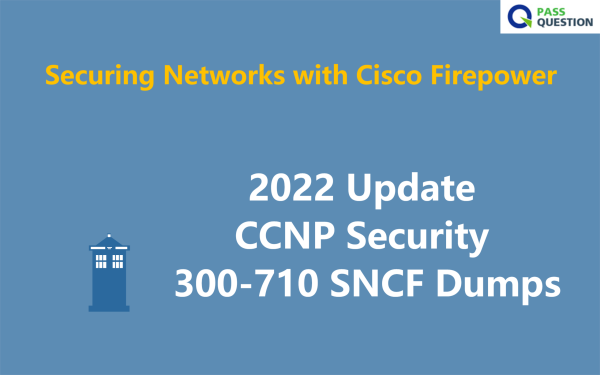2022 Update CCNP Security 300-710 SNCF Dumps
The latest CCNP Security 300-710 SNCF Dumps are new updated for your Securing Networks with Cisco Firepower exam. PassQuestion provides you the latest 300-710 questions and answers to help you attempt a real exam so you can achieve the best results. With our CCNP Security 300-710 SNCF Dumps, you can be rest assured that you will Pass your Cisco 300-710 Exam on Your First Try. It will also save your valuable time. We recommend you to go through the CCNP Security 300-710 SNCF Dumps several times so you can pass the Cisco 300-710 exam on the first attempt. It is the right way to attempt a real exam so you can achieve the best results.

300-710 SNCF Exam Description - Securing Networks with Cisco Firepower
The Securing Networks with Cisco Firepower v1.0 (SNCF 300-710) exam is a 90-minute exam associated with the CCNP Security, and Cisco Certified Specialist - Network Security Firepower certifications. This exam tests a candidate's knowledge of Cisco Firepower® Threat Defense and Firepower®, including policy configurations, integrations, deployments, management and troubleshooting.
Cisco 300-710 Exam Overview:
Exam Name: Securing Networks with Cisco Firepower
Exam Number: 300-710 SNCF
Exam Price: $300 USD
Duration: 90 minutes
Number of Questions: 55-65
Passing Score: Variable (750-850/1000 Approx.)
300-710 SNCF Exam Topics Included :
Deployment (30%)
1.1 Implement NGFW modes
1.1.a Routed mode
1.1.b Transparent mode
1.2 Implement NGIPS modes
1.2.a Passive
1.2.b Inline
1.3 Implement high availability options
1.3.a Link redundancy
1.3.b Active/standby failover
1.3.c Multi-instance
1.4 Describe IRB configurations
Configuration (30%)
2.1 Configure system settings in Cisco Firepower Management Center
2.2 Configure these policies in Cisco Firepower Management Center
2.2.a Access control
2.2.b Intrusion
2.2.c Malware and file
2.2.d DNS
2.2.e Identity
2.2.f SSL
2.2.g Prefilter
2.3 Configure these features using Cisco Firepower Management Center
2.3.a Network discovery
2.3.b Application detectors (Open AppID)
2.3.c Correlation
2.3.d Actions
2.4 Configure objects using Firepower Management Center
2.4.a Object Management
2.4.b Intrusion Rules
2.5 Configure devices using Firepower Management Center
2.5.a Device Management
2.5.b NAT
2.5.c VPN
2.5.d QoS
2.5.e Platform Settings
2.5.f Certificates
Management and Troubleshooting (25%)
3.1 Troubleshoot with FMC CLI and GUI
3.2 Configure dashboards and reporting in FMC
3.3 Troubleshoot using packet capture procedures
3.4 Analyze risk and standard reports
Integration (15%)
4.1 Configure Cisco AMP for Networks in Firepower Management Center
4.2 Configure Cisco AMP for Endpoints in Firepower Management Center
4.3 Implement Threat Intelligence Director for third-party security intelligence feeds
4.4 Describe using Cisco Threat Response for security investigations
4.5 Describe Cisco FMC PxGrid Integration with Cisco Identify Services Engine (ISE)
4.6 Describe Rapid Threat Containment (RTC) functionality within Firepower Management Center
View Online Securing Networks with Cisco Firepower 300-710 Questions and Answers
1.Which interface type allows packets to be dropped?
A. passive
B. inline
C. ERSPAN
D. TAP
Answer: B
2.An engineer is building a new access control policy using Cisco FMC. The policy must inspect a unique IPS policy as well as log rule matching.
Which action must be taken to meet these requirements?
A. Configure an IPS policy and enable per-rule logging.
B. Disable the default IPS policy and enable global logging.
C. Configure an IPS policy and enable global logging.
D. Disable the default IPS policy and enable per-rule logging.
Answer: C
3.On the advanced tab under inline set properties, which allows interfaces to emulate a passive interface?
A. transparent inline mode
B. TAP mode
C. strict TCP enforcement
D. propagate link state
Answer: D
4.A Cisco FTD has two physical interfaces assigned to a BVI. Each interface is connected to a different VLAN on the same switch.
Which firewall mode is the Cisco FTD set up to support?
A. active/active failover
B. transparent
C. routed
D. high availability clustering
Answer: C
5.An organization is migrating their Cisco ASA devices running in multicontext mode to Cisco FTD devices.
Which action must be taken to ensure that each context on the Cisco ASA is logically separated in the Cisco FTD devices?
A. Add a native instance to distribute traffic to each Cisco FTD context.
B. Add the Cisco FTD device to the Cisco ASA port channels.
C. Configure a container instance in the Cisco FTD for each context in the Cisco ASA.
D. Configure the Cisco FTD to use port channels spanning multiple networks.
Answer: C
6.An engineer is configuring a Cisco IPS to protect the network and wants to test a policy before deploying it. A copy of each incoming packet needs to be monitored while traffic flow remains constant.
Which IPS mode should be implemented to meet these requirements?
A. Inline tap
B. passive
C. transparent
D. routed
Answer: A
7.Which two dynamic routing protocols are supported in Firepower Threat Defense without using FlexConfig? (Choose two.)
A. EIGRP
B. OSPF
C. static routing
D. IS-IS
E. BGP
Answer: B,E
8.An engineer must configure high availability for the Cisco Firepower devices. The current network topology does not allow for two devices to pass traffic concurrently.
How must the devices be implemented in this environment?
A. in active/active mode
B. in a cluster span EtherChannel
C. in active/passive mode
D. in cluster interface mode
Answer: C
Comments
Post a Comment